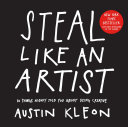

The first key idea is that nothing is truly original. Every creative work is influenced by what came before it. This concept encourages artists and creators to acknowledge their influences and to see inspiration in the works of others. Instead of fearing imitation, one should embrace it. This idea promotes the understanding that creativity is a remix of existing ideas and that by studying and borrowing from others, one can create something new and unique. The author emphasizes that the best artists are those who are able to steal ideas and transform them into something that reflects their own voice and vision.
Continue readingThe second idea revolves around the importance of embracing influence. The author suggests that instead of trying to be completely original, one should identify the artists and works that inspire them and learn from them. This process of studying the masters allows creators to develop their own style and voice. By understanding the techniques and approaches of others, individuals can build a foundation for their own creative journey. This idea encourages readers to create a 'swipe file'—a collection of inspiring works that resonate with them, which can serve as a source of motivation and guidance.
Continue readingThe third key idea is the significance of side projects and hobbies in nurturing creativity. The author argues that engaging in activities outside of one's main work can lead to unexpected insights and innovations. These side projects provide a space for experimentation and play, allowing individuals to explore new ideas without the pressure of perfection. This idea encourages readers to pursue their passions and interests, as they can often inform and enrich their primary creative endeavors. The author cites examples of successful individuals who maintained side projects that ultimately contributed to their main body of work.
Continue readingThe fourth idea is about using constraints to fuel creativity. The author posits that limitations—whether they are time, resources, or skills—can actually enhance creativity by forcing individuals to think outside the box. When faced with constraints, creators are often pushed to find innovative solutions and to work with what they have. This idea encourages readers to embrace their limitations and to see them as opportunities for creative problem-solving. The author provides examples of artists and creators who thrived under constraints, illustrating how limitations can lead to unique and impactful work.
Continue readingThe fifth key idea is the importance of being nice and working hard. The author emphasizes that success in any creative field is not just about talent, but also about attitude and effort. Building relationships and being kind to others can open doors and create opportunities. Additionally, hard work is essential in honing one's craft and achieving goals. This idea encourages readers to cultivate a positive mindset and to put in the necessary effort to develop their skills and achieve their creative aspirations. The author underscores the value of collaboration and community in the creative process.
Continue readingThe sixth idea is that creativity often involves subtraction rather than addition. The author suggests that in a world filled with distractions and noise, simplifying ideas can lead to more impactful work. By focusing on what truly matters and eliminating the unnecessary, creators can enhance the clarity and effectiveness of their message. This idea encourages readers to practice discernment in their creative process, honing in on the core elements that resonate with them and their audience. The author provides examples of how simplifying complex ideas can lead to greater understanding and engagement.
Continue readingThe final key idea is that the creative life is a journey, not a destination. The author encourages readers to embrace the process of creation and to view it as an ongoing exploration. This perspective fosters resilience and adaptability, as individuals learn to navigate the ups and downs of their creative endeavors. The author emphasizes the importance of enjoying the journey and finding fulfillment in the act of creating, rather than fixating solely on the end results. This idea encourages readers to cultivate a mindset of growth and to celebrate their progress along the way.
Continue reading